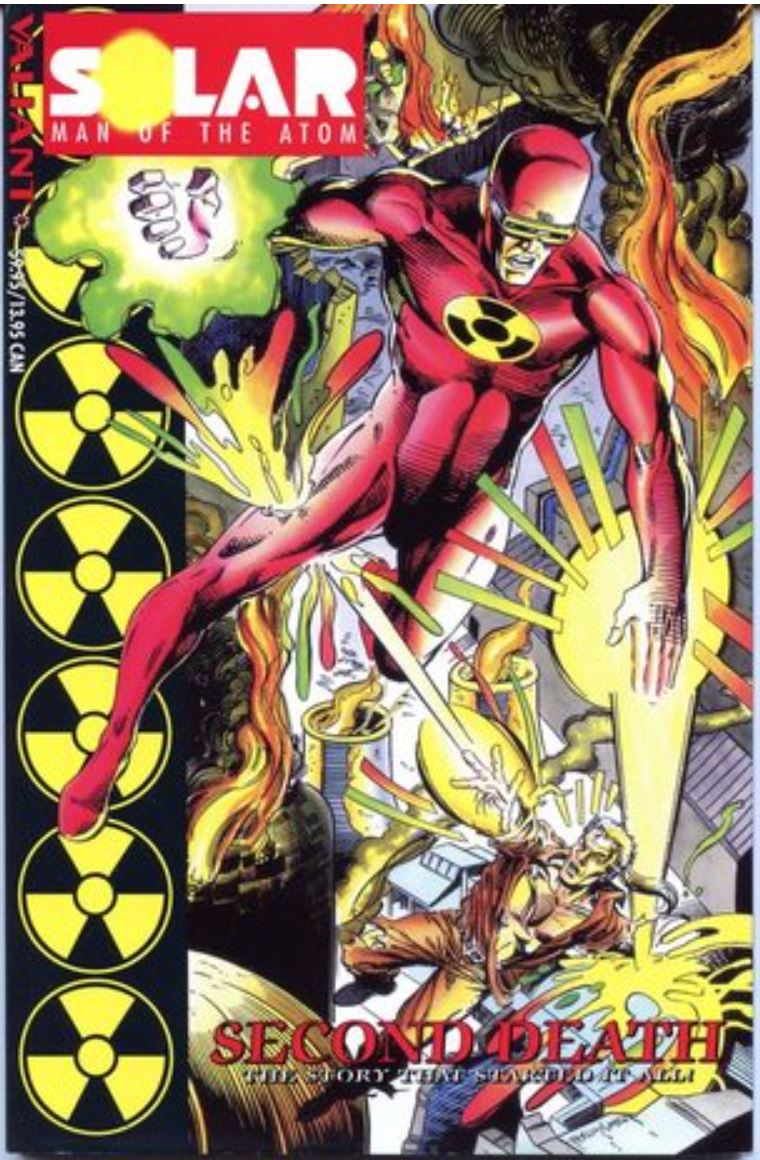
By Jim Shooter, Don Perlin, Barry Windsor-Smith, Bob Layton & Tom Ryder (Valiant)
No ISBN:
Quarterly title Doctor Solar, Man of the Atom #1 hit newsstands on June 28th1962 sporting an October cover-date. My arithmetic isn’t good enough to decipher Gold Key’s arcane system but is advanced enough to realise that’s another 60th Anniversary occurring right about now. Happy birthday, Doc!
During the market-led, gimmick-crazed frenzy of the 1990s, amongst the interminable spin-offs, fads, shiny multiple-cover events a new comics company revived some old characters and proved once more that good story-telling never goes out of fashion. As Editor-in-Chief, Jim Shooter had made Marvel the most profitable and high-profile they had ever been, and after his departure he used that writing skill and business acumen to transform some almost forgotten Silver-Age characters into contemporary gold.
Western Publishing had been a major player since comics’ earliest days, blending a huge tranche of licensed publications such as TV, movie and Disney titles; properties like Tarzan and The Lone Ranger with homegrown hits like Turok, Son of Stone and Space Family Robinson.
In the 1960s, during the second superhero boom, these original adventure titles expanded to include Brain Boy, M.A.R.S. Patrol Total War (created by Wally Wood), Magnus, Robot Fighter (by the incredible Russ Manning) and in deference to the atomic age of heroes, Nukla and the brilliantly lowkey but explosively high concept Dr. Solar, Man of the Atom. Despite supremely high quality and passionate fan-bases, they never captured the media spotlight of DC or Marvel’s costumed cut-ups. Western shut their comics division in 1984.
With an agreement to revive some, any or all of these four-colour veterans, Shooter and co-conspirator Bob Layton came to a bold decision and made those earlier adventures part-and-parcel of their refit: acutely aware that old fans don’t like having their childhood favourites bastardized, and that revivals need all the support they can get. Thus the old days were canonical: they “happened.”
Although the company launched with a classy reinterpretation of Magnus, the key title to the new universe they were building was the only broadly super-heroic character in the bunch, and they had big plans for him. Solar, Man of the Atom was launched with an eye to all the gimmicks of the era, but was cleverly realised and realistically drawn.
Second Death collects the first four issues of the revived Solar and follows brilliant nuclear physicist Phil Seleski, designer of the new Muskogee fusion reactor in the fraught days before it finally goes online. Faced with indifferent colleagues and inept superiors, pining for a woman who doesn’t seem to know he exists, Seleski is under a lot of pressure. So when he meets a god-like version of himself. he simply puts it down to stress-induced delusion…
Solar, the atomic god who was Seleski, is freshly arrived on Earth, and with his new sensibilities goes about meeting the kind of people and doing the kind of things his mortal self would never have dreamed of. As if godhood had made him finally appreciate humanity, Solar befriends bums, saves kids and fixes disasters like the heroes in the comic books he collected as a boy.
His energized matter and troubled soul even further divide into a hero and “villain”, but things take a truly bizarre turn when he falls foul of a genuine super-foe: discovering that the “normal” world is anything but, and that he is far from unique. The superhuman individuals employed and mentored in Toyo Harada’s Harbinger Foundation prove that the world has always been a fantastical place, and Solar’s belief that he has travelled back in time to prevent his own creation gives way to realisation that something even stranger has occurred…
This is a cool and knowing revision of the hallowed if not clichéd “atomic blast turns schmuck into hero” plot: brimming with sharp observation, plausible characters and frighteningly convincing pseudo-science. The understated but compelling art by hugely under-appreciated Don Perlin is a terrifying delight and adds even more shades of veracity to the mix, as do the colours of Kathryn Bolinger & Jorge Gonzãlez.
Moreover, the original comics had a special inserted component in the first 10 issues (by Shooter, Barry Windsor-Smith & Layton) revealing the epic events that made Seleski into a god. Designed to be best read only after the initial story arc had introduced readers to Seleski’s new world, these were collected as Solar, Man of the Atom: Alpha and Omega. Together they combine to form one of the most impressive and cohesive superhero origin sagas ever concocted and one desperately in need of reprinting …if whoever currently controls the licensing rights to the stories could only get their act together…
Until then you can try hunting these down via your usual internet and comic retailers, and trust me, you should…
© 1994 Voyager Communications Inc. and Western Publishing Company, Inc. All rights reserved.
